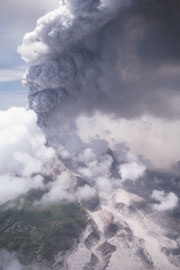geotimesheader
News
Notes
Human
Health
Volcanoes'
hidden hazards
Extended exposure
to volcanic ash particles is proving a serious health hazard. Last year,
researchers studying health effects after Montserrat’s Soufriere Hills
volcanic eruption July 18, 1995, linked the ash to lung disease. But the
andesitic lava dome’s extrusion has not settled down. Pyroclastic
flows and large ash plumes continue to harm residents.
The hidden hazards that one is exposed to in these
volcanic eruptions have long-term health effects, says Steve Sparks of
Bristol University. The greatest risk comes from volcanic ash containing
significant amounts of cristobalite and other particles less than three
microns in diameter. Inhaling these particles allows for deposition
deep in the lung. Large amounts of cristobalite can cause silicosis,
a permanent scarring disease of the lung.
Peter Baxter, a professor at the University of
Cambridge and co-author of the paper, realized that ash was a concern because
of the health issues associated with the 1980 eruption of Mount St. Helens.
Researchers established that ash from the Mount St. Helens eruption contained
cristobalite but concluded that since the eruption was relatively brief,
it did not pose a serious long-term health risk.
| “It’s a very novel situation on Montserrat where
a community is exposed to dusty conditions from a volcano for years,” Baxter
says. “In addition, the lava dome in this volcano is producing extra cristobalite
in the hot dome itself.” The researchers found that human activity was
a main factor in contributing to the extent of exposure to the very fine,
potentially harmful particles.
“One of the initial findings suggested that ash
stays on the ground for weeks if not months,” Sparks says. And human
activity can disturb the ash, break it up and resuspend it — allowing fine
particles to concentrate in greater amounts than what was originally erupted. |

| Above: A dense ash cloud
moves downwind from the Soufriere Hills volcano, Montserrat, early 1997.
Right: Vigorous ash venting followed an explosion at Montserrat's
Soufriere Hills volcano in October 1997. The wind is moving the ash cloud
over western Montserrat and pyroclastic flow deposits can be seen on the
flanks of the volcano. Photos courtesy of Simon Young, Montserrat
Volcano Observatory. |
|
 |
An andesitic lava dome grows very slowly, permitting
the gradual formation of cristobalite. Pryoclastic flows containing
this crystalline silica polymorph form when an unstable part of the dome
collapses. Initially cemented, this material becomes a serious health
hazard after people intervene by hitting clumps of material with their
cars, for example, and crushing it into very fine particles humans can
inhale.
Relative to more explosive eruptions, dome volcano
eruptions also increase the possibility that the inhaled dust is more harmful.
The dome’s collapse crushes pyroclastic material into ash. This not only
makes more particles of inhalable size, but the percentage of harmful particles
like silica and glass in fine ash is greater than in material not affected
by the eruption. “Because they are small and weak, they get selectively
crushed. Dust that you breathe in has 20 percent more [harmful particles]
than what is on the ground,” Sparks says.
The researchers — including scientists from the
University of Warwick, the British Geoloigcal Survey and the Institute
of Occupational Medicine in Edinburgh — found that ash concentrations regularly
exceeded the United Kingdom’s air quality standard for areas of frequent
ashfall.
To prevent adverse health effects, scientists
told people living near the Soufriere Hills volcano that masks, which filter
out most of the dust, are the best defense.
“We monitor the ash situation all the time to
ensure that the islanders keep out of trouble, especially children,” Baxter
says. “Not all the workers take advice about masks, and we have concerns
about some of them for the future if ash falls continue.”
Julia Cole
Geotimes contributing
writer

